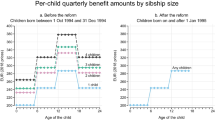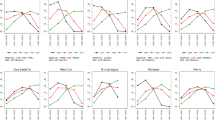Abstract
A growing body of research suggests that housing eviction is more common than previously recognized and may play an important role in the reproduction of poverty. The proportion of children affected by housing eviction, however, remains largely unknown. We estimate that one in seven children born in large U.S. cities in 1998–2000 experienced at least one eviction for nonpayment of rent or mortgage between birth and age 15. Rates of eviction were substantial across all cities and demographic groups studied, but children from disadvantaged backgrounds were most likely to experience eviction. Among those born into deep poverty, we estimate that approximately one in four were evicted by age 15. Given prior evidence that forced moves have negative consequences for children, we conclude that the high prevalence and social stratification of housing eviction are sufficient to play an important role in the reproduction of poverty and warrant greater policy attention.



Similar content being viewed by others
Notes
The misleading nature of annual reports has long been known in poverty research. Duncan and Rodgers (1988) demonstrated that approximately one-third of children under age 4 in 1968 were ever poor by age 15, despite annual estimates representing 1967, 1973, and 1979 showing that the proportion of families with children below the poverty line was only 11 % to 13 % in any given year (Danziger and Gottschalk 1985).
Based on address records, we estimate that approximately 20 % of sampled families in the Fragile Families Study resided outside the sample city’s municipal boundaries at the time of the focal child’s birth.
We estimate that only 14.9 % (unweighted) of parents who reported an eviction lived in an owned home at the previous wave, suggesting that the large majority of evictions (85.1 %) were due to nonpayment of rent. This estimate excludes 26.2 % of eviction reports for which housing status in the prior wave is not known.
For children who live at least one-half of the time with their mothers, we use the mother’s report. Otherwise, for those who live at least one-half the time with their father, we use the father’s report. All others are missing. At age 15, eviction is reported for all children by their primary caregiver.
The proportion of children who have experienced multiple evictions is also an important research question. An absolute lower bound on this proportion is the 1.1 % (CI: 0.1–1.4 %) of the sample that reported eviction in two or more waves. Multiply imputing to fill missing survey reports, we estimate that 1.8 % (CI: 1.0–2.7 %) were evicted in multiple waves. Our parametric model implies that 4.9 % (CI: 3.9–6.1 %) of children born in large U.S. cities in 1998–2000 were evicted in multiple years between birth and age 15. However, these estimates may substantially understate the prevalence of serial evictions because questions asked whether respondents were ever evicted in each reporting period, not the number of evictions. Because serial evictions may occur in quick succession within a single reporting period, we leave more definitive claims about the prevalence of serial eviction to future research.
The point estimate is a lower bound on the weighted sample proportion evicted. The bootstrapped 95 % confidence interval captures estimation uncertainty about the population proportion.
Throughout, CI refers to a 95 % quantile-based bootstrapped confidence interval for frequentist estimates or a 95 % quantile-based posterior credible interval for Bayesian estimates.
Because our primary goal is prediction, we also considered random forests as a nonparametric alternative. For details, see the online appendix, part 5.
Logistic regression estimates are consistent but biased in finite samples, often underpredicting rare events, such as eviction (King and Zeng 2001). Cross-validation suggests that the bias is small in our case (see the online appendix, part 4).
We also examined how eviction varied by city of birth. Prevalence is substantial in all sampled cities, but we found suggestive evidence of some variation from 12.1 % (born in Chicago, CI: 7.0–18.1 %) to 23.5 % (born in Detroit, CI: 18.9–28.7 %). Because estimates are imprecise and because sample cities indicate children’s city of birth, not city of eviction, we treat this evidence as suggestive and call for future research on geographic heterogeneity in eviction prevalence. For details, see the online appendix, part 6.
References
Amorim, M., Dunifon, R., & Pilkauskas, N. (2017). The magnitude and timing of grandparental coresidence during childhood in the United States. Demographic Research, 37(article 52), 1695–1706. https://doi.org/10.4054/DemRes.2017.37.52
Bauman, K. J. (2003). Extended measures of well-being: Living conditions in the United States: 1998 (Current Population Reports: Household Economic Studies Series P70–87). Washington, DC: U.S. Census Bureau.
Carpenter, B., Gelman, A., Hoffman, M. D., Lee, D., Goodrich, B., Betancourt, M., . . . Riddell, A. (2017). Stan: A probabilistic programming language. Journal of Statistical Software, 76(1). https://doi.org/10.18637/jss.v076.i01
Danziger, S., & Gottschalk, P. (1985). How have families with children been faring? (Report prepared for the Joint Economic Committee of the Congress). Madison: University of Wisconsin Institute for Research on Poverty. Retrieved from http://files.eric.ed.gov/fulltext/ED268189.pdf
Desmond, M. (2012). Eviction and the reproduction of urban poverty. American Journal of Sociology, 118, 88–133.
Desmond, M. (2015). Unaffordable America: Poverty, housing, and eviction (Fast Focus Report No. 22). Madison: University of Wisconsin Institute for Research on Poverty.
Desmond, M. (2016). Evicted: Poverty and profit in the American city. New York, NY: Crown.
Desmond, M., An, W., Winkler, R., & Ferriss, T. (2013). Evicting children. Social Forces, 92, 303–327.
Desmond, M., Gershenson, C., & Kiviat, B. (2015). Forced relocation and residential instability among urban renters. Social Service Review, 89, 227–262.
Desmond, M., Gromis, A., Edmonds, L., Hendrickson, J., Krywokulski, K., Leung, L., & Porton, A. (2018). Eviction lab national database: Version 1.0. Princeton, NJ: Princeton University. Available from www.evictionlab.org
Desmond, M., & Kimbro, R. T. (2015). Eviction’s fallout: Housing, hardship, and health. Social Forces, 94, 295–324.
Desmond, M., & Shollenberger, T. (2015). Forced displacement from rental housing: Prevalence and neighborhood consequences. Demography, 52, 1751–1772.
Duncan, G. J., & Rodgers, W. L. (1988). Longitudinal aspects of childhood poverty. Journal of Marriage and the Family, 50, 1007–1021.
Gelman, A., Jakulin, A., Pittau, M. G., & Su, Y.-S. (2008). A weakly informative default prior distribution for logistic and other regression models. Annals of Applied Statistics, 2, 1360–1383.
Gould-Werth, A., & Seefeldt, K. S. (2012). Material hardships during the Great Recession: Findings from the Michigan Recession and Recovery Study (National Poverty Center Policy Brief No. 35). Ann Arbor: University of Michigan Poverty Solutions. Retrieved from http://www.npc.umich.edu/publications/policy_briefs/brief35
Joint Center for Housing Studies of Harvard University. (2017). The state of the nation’s housing (Report). Cambridge, MA: Joint Center for Housing Studies. Retrieved from http://www.jchs.harvard.edu/sites/jchs.harvard.edu/files/harvard_jchs_state_of_the_nations_housing_2017.pdf
King, G., & Zeng, L. (2001). Logistic regression in rare events data. Political Analysis, 9, 137–163.
Mayer, S. E., & Jencks, C. (1989). Poverty and the distribution of material hardship. Journal of Human Resources, 24, 88–114.
Reichman, N. E., Teitler, J. O., Garfinkel, I., & McLanahan, S. S. (2001). Fragile Families: Sample and design. Children and Youth Services Review, 23, 303–326.
Stan Development Team. (2017). RStan: The R interface to Stan (R package version 2.16.2) [Software]. Available from: http://mc-stan.org
Wildeman, C. (2009). Parental imprisonment, the prison boom, and the concentration of childhood disadvantage. Demography, 46, 265–280.
Acknowledgments
We thank Sara S. McLanahan, Brandon M. Stewart, Matthew J. Salganik, three anonymous reviewers, and members of the Stewart Lab and the Fragile Families Working Group for comments on early drafts. We thank the Demography copyeditors for helping to improve our prose. All errors are our own. Research reported in this publication was supported by the Robert Wood Johnson Foundation and by The Eunice Kennedy Shriver National Institute of Child Health & Human Development of the National Institutes of Health under Award Number P2CHD047879. Funding for the Fragile Families Study was provided through Award Numbers R01HD36916, R01HD39135, and R01HD40421, and by a consortium of private foundations. The content is solely the responsibility of the authors and does not necessarily represent the official views of the National Institutes of Health.
Author information
Authors and Affiliations
Corresponding author
Additional information
The replication code is available on the Harvard Dataverse: https://doi.org/10.7910/DVN/BVWFG1.
Electronic supplementary material
ESM 1
(PDF 944 kb)
Rights and permissions
About this article
Cite this article
Lundberg, I., Donnelly, L. A Research Note on the Prevalence of Housing Eviction Among Children Born in U.S. Cities . Demography 56, 391–404 (2019). https://doi.org/10.1007/s13524-018-0735-y
Published:
Issue Date:
DOI: https://doi.org/10.1007/s13524-018-0735-y




